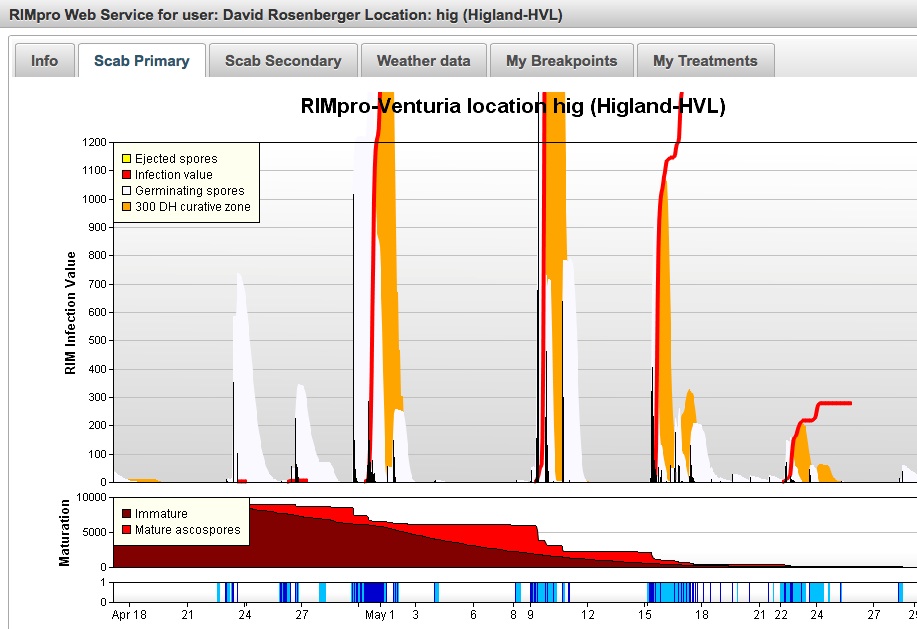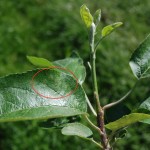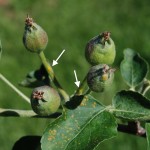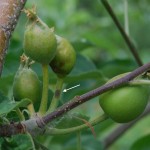Thursday, 29 May 2014: Despite my dire predictions in earlier blog posts, apple scab has been very slow to appear in the Hudson Valley this year. Severity of anticipated infection periods in mid-April was diminished when temperatures ended up being lower and/or wetting periods were shorter than weather forecasters had predicted. However, the RIMpro model for apple scab that we began evaluating this year indicated that we had an “off-the-charts” infection period that started on 29 April (see graph below) followed by two more later in May. The RIMpro model has been developed, extensively evaluated, and widely used in Europe for many years. For spore maturity predictions in the Hudson Valley, RIMpro accessed weather data from the Highland NEWA station to predict ascospore maturation and discharge as well as the potential for infection based weather during the infection period.

Once again nature has defied our expectations because neither I nor local consultants were able to find scab on unsprayed trees prior to last weekend (May 26-27). Even now the lesions appearing on unsprayed McIntosh trees at the Hudson Valley Lab are still rather faint (Fig. 1 below). However, starting earlier this week, consultants began finding scab in commercial orchards where spray coverage was inadequate during at least one of the critical infection periods in May. The position of infected leaves, both here at the lab and in commercial orchards, and the timing of lesion appearance indicates that the infections that appeared this week probably occurred May 9-11, not in late April, because the leaves showing infections had not yet formed in late April. Thus, the predicted scab infection for late April apparently failed to result in detectable infections this year, perhaps because that infection period included 2.35 inches of rainfall and the heavy rain may have washed most spores out of the air and/or off of leaves before the infection process could be completed.
That was not the case with cedar apple rust, however, which is now visible on cluster leaves and fruit (Fig. 2) in plots at the Hudson Valley Lab where we have cedar trees planted between our test plots to ensure uniformly high levels of inoculum. Cedar apple rust lesions are sometimes evident on fruitlet stems at this time of year where they are easily identified by the bright yellow color of the lesions (note the arrows in Fig. 2). Quince rust, which I have not yet seen this year, can also infect fruit stems, but it causes distortion of the stems (Fig. 3) rather than bright yellow dots of color. In some years we also find apple scab on fruitlet stems (Fig. 4).
When infections occur on flower pedicels and disease symptoms appear on fruitlet stems, the infections usually cause the fruitlets to die and abscise before harvest. In 1998 we were evaluating numerous cultivars for scab susceptibility and therefore left trees unsprayed during the early part of the season. That year the incidence of scab on fruitlet stems was so high that almost all of the fruit dropped from scab-susceptible cultivars before we could collect fruit for disease evaluations.
Although scab was slow to appear this year, we anticipate that it will rapidly become more apparent where fungicide coverage was inadequate. Where primary scab is present, fungicides will still be needed at weekly intervals for a few more weeks in order to prevent secondary infections of fruit and new leaves.
- Fig. 1. First scab lesions of 2014 photographed 29 May on unsprayed ‘McIntosh’ trees.
- Fig. 2. Cedar apple rust lesions on ‘Ginger Gold’ leaves, fruit, and fruit stems 29 May 14
- Fig. 3. Quince rust infections on fruit stems of ‘Delblush’ apples
- Fig. 4. Apple scab lesion on stem of ‘Ginger Gold’ fruitlet photographed 4 June 08




